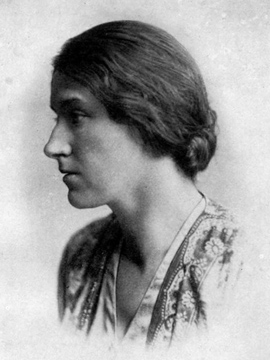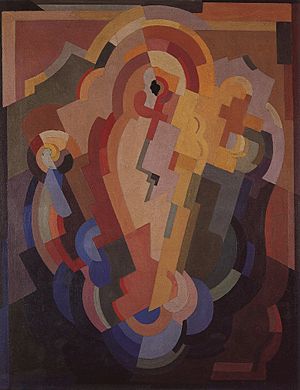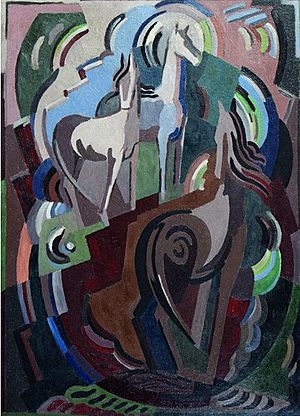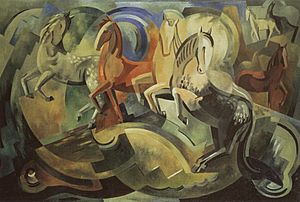Mainie Jellett facts for kids
Mary Harriet "Mainie" Jellett (born April 29, 1897 – died February 16, 1944) was an important Irish painter. Her painting Decoration (1923) was one of the first abstract artworks ever shown in Ireland. This happened at a group art show in Dublin in 1923.
Mainie Jellett was a strong supporter of modern art in Ireland. Her paintings are now in many museums across the country. She even had her artwork featured in the painting event at the 1928 Summer Olympics.
Contents
Early Life and Art Education
Mainie Jellett was born in Dublin, Ireland, on April 29, 1897. She was one of four daughters. Her father, William Morgan Jellett, was a lawyer and later a politician. Her mother, Janet McKenzie Stokes, was a talented musician. All the Jellett daughters learned to play music. Mainie's sister, Dorothea, even conducted an orchestra in Dublin. Her aunt, Eva Jellett, was a doctor who did important work in India.
Mainie started her art lessons at age 11. She learned from famous artists like Elizabeth Yeats and Sarah Cecilia Harrison. She later studied at the Metropolitan School of Art in Dublin. Here, she was taught by William Orpen, whose style influenced her early work.
At first, Mainie wasn't sure if she wanted to be a painter or a concert pianist. She took many piano lessons. But after studying with artist Walter Sickert in London from 1917 to 1919, she decided to become a painter. She quickly showed great talent in the Impressionist style of painting. In 1920, she won a special art scholarship worth £50. That same year, her work was shown at the Royal Hibernian Academy's yearly exhibition.
Developing Her Unique Art Style
In 1921, Mainie Jellett moved to Paris with her friend, Evie Hone. There, they studied with artists André Lhote and Albert Gleizes. This is where Mainie discovered Cubism and began to explore abstract art. Her time in France greatly inspired her new style, which used bold colors and strong rhythms.
After 1921, Mainie and Evie returned to Dublin. However, for the next ten years, they spent part of each year in Paris. In an essay she wrote in 1943, Mainie explained that three teachers influenced her art the most: Walter Sickert, André Lhote, and Albert Gleizes.
Introducing Abstract Art to Ireland
In 1923, Mainie showed two of her Cubist paintings at an exhibition in Dublin. People's reactions were not positive. The Irish Times newspaper even published a photo of one painting. Their art critic said the artwork was "an insoluble puzzle." The next year, Mainie and Evie Hone held their first art show together.
Mainie Jellett was a very religious person. Even though her paintings were often abstract, some had religious titles. They sometimes looked like icons, which are religious images. Art historian Bruce Arnold described her abstract works. He said many of them start from a central point. Colors then spread out in arcs, held together by lines and shapes. This gave her paintings a sense of depth and energy.
Championing Modern Art
Mainie Jellett was a very important person in Irish art. She was one of the first to create abstract art in Ireland. She also strongly supported the modern art movement. Her paintings were often criticized, but she was always ready to defend her ideas.
In 1944, Mainie Jellett helped start the Irish Exhibition of Living Art. She worked with other artists like Evie Hone and Louis le Brocquy. In her 1942 writing, "An Approach To Painting," Mainie explained why artists are important to society:
"The idea of an artist being a special person... is one of the errors resulting from the industrial revolution... Their present enforced isolation from the majority is a very serious situation... The art of a nation is one of the ultimate facts by which its spiritual health is judged..."
She believed that art shows the true spirit of a country.
Death and Lasting Impact
Mainie Jellett passed away in Dublin on February 16, 1944. She was 46 years old. A writer named Elizabeth Bowen wrote a touching tribute to her in a magazine called The Bell. Bowen mentioned that Mainie always supported other women, showing her belief in the feminist movement.
Today, a special plaque marks her former home and studio in Dublin. Mainie Jellett's work was also a key part of a project at the Irish Museum of Modern Art (IMMA). This project aimed to highlight artists who might not be as well-known outside of Ireland. Mainie was a pioneer of modern art in her country. IMMA wanted to bring artists like her to the forefront of European art history.
In 1990, Bruce Arnold created a documentary about Mainie Jellett called To Make it Live. He also wrote a detailed book about her life and the modern art movement in Ireland in 1991.
Mainie Jellett's Art in Collections
You can find Mainie Jellett's artwork in many art galleries and museums, including:
- Crawford Art Gallery, Cork
- Niland Art Collection, Sligo
- Butler Gallery Collection, Kilkenny
- Trinity College, Dublin
- The Hugh Lane Municipal Gallery, Dublin
- The Irish Museum of Modern Art, Dublin
- The National Gallery of Ireland, Dublin
- Greyfriars Municipal Art Gallery, Waterford
- Ulster Museum, Belfast, UK
See also
 In Spanish: Mainie Jellett para niños
In Spanish: Mainie Jellett para niños





